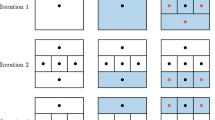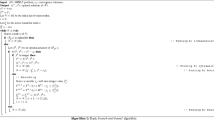Abstract
Recent discussions in the editorial committee of the SMO Journal, following a forum article (Sigmund, Struct Multidisc Optim 43(5):589–596, 2011) on non-gradient methods in topology optimization, have shown that an analysis of global optimization contributions to SMO might be useful.
Similar content being viewed by others
Avoid common mistakes on your manuscript.
1 Scope of the article: global optimization algorithms
Global optimization methods aim to avoid getting trapped at local, suboptimal, points. They may, as in local restart methods, or may not, as in standard evolutionary algorithms, use gradient information. They concern continuous, discrete, or mixed design variables. Local optima often appear in discrete optimization problems, which therefore is a predominant field of application of global optimization. Theoretical convergence proofs of global optimization algorithms are typically established as the number of optimization criteria evaluations tends to infinity. Moreover, any algorithm can be made asymptotically global (in probability) by adding a small noise to the iterates (Auger and Hansen 2011). For these reasons, theoretical global convergence is likely to be of limited interest to most SMO Journal readers. In practice, the important feature of these algorithms is the ability to locate, at an acceptable computing cost, better solutions to multimodal problems than local searches would. For problems with large number of local optima, or with deceptive optima (overall trends leading away from the optimum) convergence to the global optima requires very large number of evaluations of the optimization criteria.
When the many thousands of evaluations needed cannot be afforded, settling for local searches is an often used solution. Consequently, transformations that can greatly reduce the number of local optima, were invented that allow us to fall back on gradient based methods (which can be restarted from different points).
It is interesting to note that SIMPFootnote 1 is a transformation that converts the binary topology optimization (we want a black and white solution) to a continuous differentiable problem apparently without creating a large number of local optima. As is apparent from Sigmund (2011), once such a transformation is found, its practitioners find it difficult to understand why one would want to attack the discrete problem directly using expensive discrete optimization methods.
Another popular example of such transformation methods is the use of lamination parameters for finding the optimal stacking sequence of a composite laminate (Fukunaga and Vanderplaats 1991). This approach reduces the number of design variables and local optima, and so it is particularly useful when the ply orientations vary from point to point (e.g., Ijsselmuiden et al. 2010). Papers on these methods clearly belong in SMO, and so they will not be discussed further.
2 An analysis of the global optimization literature
An important goal of a journal is to publish papers that would be useful to its readers, and one common measure of usefulness is the number of citations. Of course, it is an imperfect measure in that a paper may garner many citations for other reasons. However, it is the best measure that we presently have. Appendix A provides a list of global optimization articles, with structural or fluid mechanics applications, which have received over 100 citations on Google Scholar. Two observations can be made from this list:
Firstly, the vast majority of these articles deal with metaphorical stochastic methods (evolutionary/genetic algorithms, particle swarm and harmony search). In other words, deterministic and more mathematically oriented contributions are not as much cited.
Secondly, the majority of these articles proposes a specialization of a general method to a mechanical problem, as opposed to articles that propose a new general method.
Good articles about new global optimization methods (in contrast to tweaks on existing methods) have not been published in SMO but in more mathematically oriented journals. SMO may want to focus on applications in mechanical engineering, and particularly encourage specializations to applications requiring solid mechanics and fluid mechanics simulations.
Since many SMO readers are interested in metaphorical based global optimization contributions, SMO may want to continue publishing such contributions. However, a large number of submitted articles of this category have a poor scientific quality and are not very useful, as evidenced by very few citations. Therefore, editorial guidelines are needed to clarify what is demanded from authors. We propose such guidelines. In particular, since most metaphorical global optimization methods are empirically tested (convergence results are almost never accessible), standards about the testing procedure might be proposed. The metaphor used to present the method should also be mathematically formalized in order to allow comparison with other existing methods. The starting rapid screening procedure might also be systematically resorted to for this category of articles.
3 Proposed editorial guidelines
The following guidelines might be included in the “Instructions for Authors” of SMO Journal.
1. Metaphor-based optimization methods
Metaphorical optimization methods like evolutionary/genetic algorithms, particle swarm optimization, harmony search, ant colony, Tabu search, ..., should be properly formalized as algorithms, for example through pseudo-code or mathematical formulation devoid of the metaphor. When it is claimed that the algorithm or portions of it are new, the difference with existing metaphorical optimization algorithms or other related optimization methods should be clearly explained. For example, the generation of a harmony matrix in harmony search algorithms is similar to the application of a uniform crossover in genetic algorithms. The chaotic imperialist competitive algorithm resembles island models in genetic algorithms and particle swarm optimizations. The hybrid cellular automaton in topology optimization is close to other filtering schemes such as the slope control formulation (Petersson and Sigmund 1998)... The choice of one reviewer who has not published articles about the particular metaphor which is being proposed should be encouraged.
Metaphor-based optimization methods usually come with parameters whose tuning needs to be properly analyzed. Typically, the relationship between these parameters and the number of design variables should be discussed.
2. Non-deterministic optimization algorithms
Non-deterministic optimization algorithms such as probabilistically restarted local searches, Bayesian optimization, simulated annealing, stochastic gradient methods, and evolutionary algorithms, do not yield the same result when restarted with the same parameters. Therefore, submissions containing empirical results based on non-deterministic optimization algorithms should provide proper statistical tests, i.e., repeated sample tests with measures of performance and spread (e.g., mean, variances, percentiles, confidence levels...).
3. Test problems
Global optimization methods are not general purpose like local searches. The ‘no free lunch’ paradigm states that if a global optimization algorithm works well for some problems, it will work poorly for others. Therefore, authors should explain what in their algorithm is particularly suited to what class of structural or fluid mechanics problems and provide examples of applications to such problems. Examples should be chosen with strong preference to structural or fluid problems tested with other algorithms. It is important that test problems include ones that cannot be solved more efficiently by restarted gradient methods. The aspect of the problem that makes it difficult for restarted global methods (e.g., very large number of local optima or deceptive optima) should be clearly established.
Finally, we notice that many scientifically recognized teams that work in global optimization with SMO applications do not reach the 100 citations. Examples of such contributions, which could be in SMO scope and raise the journal quality, are listed in Appendix B. It seems also necessary for SMO to remain attractive to such contributions by keeping a balance between metaphorical and other global optimization articles.
Notes
SIMP: Solid Isotropic Material with Penalization.
References
Auger A, Hansen N (2011) Theory of evolution strategies: a new perspective. In: Auger A, Doerr B (eds) Theory of randomized search heuristics: foundations and recent developments. World Scientific Publishing, pp 289–325
Fukunaga H, Vanderplaats GN (1991) Stiffness optimization of orthotropic laminated composites using lamination parameters. AIAA J 29(4):641–646
Ijsselmuiden ST, Abdalla MM, Gürdal Z (2010) Optimization of variable stiffness panels for maximum buckling load using lamination parameters. AIAA J 48(1):134–143
Petersson J, Sigmund O (1998) Slope constrained topology optimization. Int J Numer Methods Eng 41:1417–1434
Sigmund O (2011) On the usefulness of non-gradient approaches in topology optimization. Struct Multidisc Optim 43(5):589–596
Author information
Authors and Affiliations
Corresponding author
Appendices
Appendix A: Some articles dealing with global optimization applied to structural or fluid mechanics with over 100 google scholar citations in October 2011
[The following articles were found (1) by using the key words “global” and “optimization” in Google Scholar (2) in the authors bibliographical lists]
Cheng NT (1994) Augmented Lagrangian genetic algorithm for structural optimization. J Aerosp Eng 7(1):104–118. ISI 79, Google 127
Daven DM, Tit N, Morris JR, Ho KM (1996) Structural optimization of Lennard–Jones clusters by a genetic algorithm. Chem Phys Lett 256(1–2):195–200. ISI 150, Google 205
Fourie PC, Groenwold AA (2002) The particle swarm optimization algorithm in size and shape optimization Struct Multidisc Optim 23(4):259–267. ISI: 97, Google: 171
Hajela P (1990) Genetic search—an approach to the nonconvex optimization problem AIAA J 28(7):1205–1210. ISI 90, Google 182
Hajela P, Lin C-Y (1992) Genetic search strategies in multicriterion optimal design. Struct Multidisc Optim 4(2):99–107. Google 492
Jenkins WM (1991) Towards structural optimization via the genetic algorithm. Comput Struct 40(5):1321–1327. ISI 89, Google 147
Jones DR, Schonlau M, Welch WJ (1998) Efficient global optimization of expensive Black-Box functions. J Glob Optim 13(4). Google 768
Krishnamoorthy CS, Rajeev S (1992) Discrete optimization of structures using genetic algorithms J Struct Eng - ASCE 118(5):1233-1250. ISI 226, Google 334
Le Riche R, Haftka RT (1993) Optimization of laminate sequence for buckling load maximization by genetic algorithm. AIAA J 31(5):564–570. ISI 135, Google 269
Lee KS, Geem ZW (2004) A new structural optimization method based on the harmony search algorithm. Comput Struct 82(9–10):781–198. ISI 129, Google 206
Lin CY, Hajela P (1992) Genetic algorithms in optimization problems with discrete and integer design variables. Eng Optim 19(4):309–327. Google 136
Nagendra S, Jestin D, Gürdal Z, Haftka RT, Watson LT (1996) Improved genetic algorithms for the design of stiffened composite panels. Comput Struct 58(3):543–555. ISI 73, Google 105
Ong YS, Nair PB, Keane AJ (2003) Evolutionary optimization of computationally expensive problems via surrogate modeling. AIAA J 41(4):687–696. Google 150
Schutte JF, Reinbolt JA, Fregly BJ, Haftka RT, George AD (2004) Parallel global optimization with the particle swarm algorithm. Int J Numer Methods Eng 61:2296–2315. doi:10.1002/nme.1149. Google 155
Appendix B: Complementary list of publications about global optimization with mechanical engineering applications
[These articles are examples of global optimization contributions with mechanical applications coming from recognized teams in the field and which are not based on metaphors.]
Bichon BJ, Eldred MS, Swiler LP, Mahadevan S, McFarland JM (2007) Multimodal reliability assessment for complex engineering applications using efficient global optimization, paper AIAA-2007-1946. In: Proceedings of the 48th AIAA/ASME/ASCE/AHS/ASC structures, structural dynamics and materials conference (9th AIAA non-deterministic approaches conference), Honolulu, HI, 23–26 April, Google 12
Bieniawski SR, Kroo IM, Wolpert DH (2004) Discrete, continuous, and constrained optimization using collectives. In: Proceedings of 10th AIAA/ISSMO multidisciplinary analysis and optimization conference. Google 44
Cox SE, Haftka RT, Baker CA, Grossman B, Mason WH, Watson LT (2001) A comparison of global optimization methods for the design of a high-speed civil transport. J Glob Optim 21:415–433. Google 42
Eldred MS, Hart WE, Bohnhoff WJ, Romero VJ, Hutchinson SA, Salinger AG (1996) Utilizing object-oriented design to build advanced optimization strategies with generic implementation. In: AIAA/NASA/ISSMO 6th symposium on multidisciplinary analysis and optimization, AIAA Paper 96-4164, Reston, VA. Google 35
Villemonteix J, Vazquez E, Sidorkiewicz M, Walter E (2008) Global optimization of expensive-to-evaluate functions: an empirical comparison of two sampling criteria. J Glob Optim 43(2):373–389. Google 17
Rights and permissions
About this article
Cite this article
Le Riche, R., Haftka, R.T. On global optimization articles in SMO. Struct Multidisc Optim 46, 627–629 (2012). https://doi.org/10.1007/s00158-012-0785-5
Received:
Revised:
Accepted:
Published:
Issue Date:
DOI: https://doi.org/10.1007/s00158-012-0785-5




